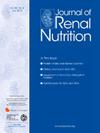联合临床虚弱评分和肌肉生长抑制素浓度作为血液透析患者死亡率的预测因子。
IF 3.2
3区 医学
Q2 NUTRITION & DIETETICS
引用次数: 0
摘要
背景与目的:虚弱在血液透析(HD)患者中很常见。其评估通常基于临床标准。在目前的工作中,我们评估了结合临床虚弱评分和生物标志物来预测慢性HD患者死亡率的兴趣。评估四项生物标志物:肌肉生长抑制素、胰岛素样生长因子-1 (IGF-1)、硫酸脱氢表雄酮(DHEA-S)和血清肌酐与囊抑素C比值(SCr/SCys)。方法:本观察性前瞻性研究于2016年9月至2017年10月在两个中心招募了流行HD患者,随访5年。在基线时测定血清肌生长抑制素、IGF-1、DHEA-S和SCr/SCys水平。采用Fried衰弱评分(≥3表示虚弱)评估虚弱程度。通过计算Cox回归分析和曲线下面积(AUC)来评估预测5年死亡率的能力。结果:我们纳入125例HD患者,其特征如下:中位年龄67[53;78]岁;40%的女性;41%的糖尿病患者,中位透析时间为30[16;54]个月。其中,46%的人根据弗里德评分被归为“虚弱”。5岁死亡率为56%。中位随访时间为49[19;60]个月。Cox单因素分析显示,较高的年龄、脆弱表型和降低的肌肉生长抑制素、IGF-1、DHEA-S和SCr/SCys浓度与较高的死亡率相关。在多变量分析中,只有肌生长抑制素在生物标志物中保持显著性。Fried评分和肌生长抑制素预测死亡率的AUC具有显著性和可比性:分别为0.72 (95% CI: 0.63至0.80)和0.72 (95% CI: 0.64至0.80)。与单独使用Fried评分或单独使用myostatin相比,联合使用myostatin可显著提高AUC (AUC = 0.79, 95% CI: 0.71 ~ 0.86) (p=0.0049和p=0.0035)。结论:肌生长抑制素浓度降低似乎与较高的死亡风险独立相关。结合Fried衰弱评分和肌生长抑制素浓度可以提高慢性HD患者5年死亡率的预测。本文章由计算机程序翻译,如有差异,请以英文原文为准。
Combination of Clinical Frailty Score and Myostatin Concentrations as Mortality Predictor in Hemodialysis Patients
Objectives
Frailty is common among hemodialysis (HD) patients. Its assessment is usually based on clinical criteria. In the present work, we evaluated the interest of combining clinical frailty score and biomarkers to predict mortality of chronic HD patients. Four biomarkers were assessed: myostatin, insulin-like growth factor-1 (IGF-1), dehydroepiandrosterone sulfate (DHEA-S), and serum creatinine-to-cystatin C ratio (SCr/SCys).
Methods
Prevalent HD patients were enrolled from September 2016 to October 2017 in 2 centers in this observational prospective study and followed up for 5 years. Serum levels of myostatin, IGF-1, DHEA-S, and SCr/SCys were measured at baseline. Frailty was assessed using Fried frailty score (≥ 3 indicates frailty). The ability to predict 5-year mortality was assessed by calculating Cox regression analyses and areas under the curve (AUCs).
Results
We included 125 HD patients with the following characteristics: median age of 67 (53; 78) years, 40% of women, 41% of diabetics, and median dialysis vintage of 30 (16; 54) months. Among them, 46% were classified as “Frail” according to Fried score. Mortality rate at 5 years was 56%. The median follow-up was 49 (19; 60) months. Cox univariate analysis showed that higher age, frailty phenotype, and decreased concentrations of myostatin, IGF-1, DHEA-S, and SCr/SCys were associated with higher mortality. In multivariate analysis, only myostatin remained significant among the biomarkers. The AUC of Fried score and myostatin to predict mortality was significant and comparable: 0.72 (95% confidence interval [CI]: 0.63-0.80) and 0.72 (95% CI: 0.64-0.80), respectively. Combining myostatin with Fried score improved significantly the AUC (AUC = 0.79, 95% CI: 0.71-0.86) compared to Fried score alone or myostatin alone (P = .0049 and P = .0035, respectively).
Conclusion
Decreased concentrations of myostatin seem to be independently associated with higher risk of mortality. Combining Fried frailty score with myostatin concentration could improve the prediction of 5-year mortality in chronic HD patients.
求助全文
通过发布文献求助,成功后即可免费获取论文全文。
去求助
来源期刊

Journal of Renal Nutrition
医学-泌尿学与肾脏学
CiteScore
5.70
自引率
12.50%
发文量
146
审稿时长
6.7 weeks
期刊介绍:
The Journal of Renal Nutrition is devoted exclusively to renal nutrition science and renal dietetics. Its content is appropriate for nutritionists, physicians and researchers working in nephrology. Each issue contains a state-of-the-art review, original research, articles on the clinical management and education of patients, a current literature review, and nutritional analysis of food products that have clinical relevance.
 求助内容:
求助内容: 应助结果提醒方式:
应助结果提醒方式:


